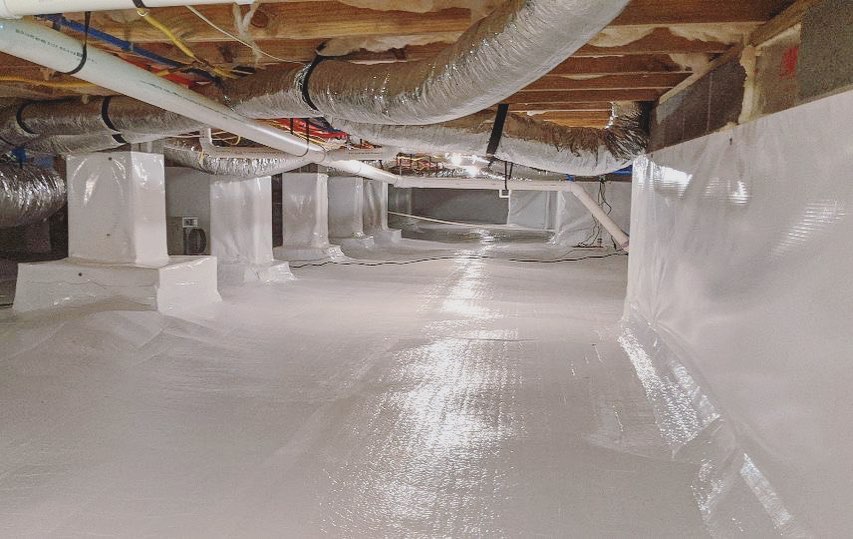Many homeowners spend considerable time and money upgrading windows, insulation, and HVAC systems to make their homes more energy-efficient and comfortable. Yet, one of the most overlooked areas of the house—often ignored until it becomes a problem—is the crawlspace. What happens in this hidden area beneath your home can significantly impact your air quality, energy consumption, and even your property’s long-term value.
This comprehensive guide explores the importance of a sealed crawlspace, how it works, what benefits it offers, and why it may be one of the smartest home improvements you can make. Whether you’re a new homeowner or considering a home performance upgrade, understanding how the space beneath your feet influences your quality of life is a critical step toward a healthier living environment.
Why Crawlspaces Matter More Than You Think
A crawlspace, typically ranging from one to three feet in height, is the hollow area between the ground and the first floor of your home. While it might not be as accessible or visible as a basement, it serves multiple purposes. It often houses vital systems like ductwork, electrical wiring, plumbing lines, and insulation. Because of its low elevation and exposure to soil, the crawlspace is prone to excess moisture, pests, and mold—all of which can pose serious issues.
A poorly maintained crawlspace can:
- Contribute to poor indoor air quality
- Create an ideal environment for mold and mildew
- Attract pests and rodents
- Lead to wood rot and structural damage
- Increase energy bills due to heat loss or humidity
Surprisingly, up to 50% of the air circulating in your home can originate from the crawlspace. If that area is filled with mold spores, dust, or moisture, those pollutants will eventually make their way into your living space.
The Science Behind Moisture in Crawlspaces
Moisture is the crawlspace’s biggest enemy. Water vapor from the ground rises and condenses on cooler surfaces like ductwork, insulation, and floor joists. Even in homes without standing water, this continuous vapor intrusion can slowly damage materials and encourage fungal growth.
Additionally, many crawlspaces are ventilated by design, based on outdated construction philosophies. While the idea was to allow moisture to escape, the reality is that these vents often allow humid air in—especially during summer. When warm air meets cooler surfaces, condensation occurs, creating the ideal breeding ground for mold.
In winter, unsealed crawlspaces can lead to frozen pipes and dramatically increased heating costs as cold air infiltrates the structure.
What Is Crawlspace Encapsulation?
Crawlspace Encapsulation is the process of sealing off the crawlspace from the ground and outdoor air to create a clean, controlled environment beneath your home. This is achieved by installing a heavy-duty vapor barrier along the crawlspace floor and walls, sealing all vents and gaps, and often including a dehumidification system to regulate moisture levels.
This method transforms the crawlspace from a dark, damp, and often neglected space into a dry, clean, and insulated area that supports the overall performance of your home.
Components typically include:
- Vapor Barrier: A thick polyethylene liner that prevents ground moisture from seeping into the crawlspace air.
- Vent Sealing: Foam or insulated covers are used to block outdoor air from entering through crawlspace vents.
- Seam Sealing: Special tape and adhesive materials ensure that all overlaps and wall-to-floor transitions are airtight.
- Insulation: In some systems, rigid foam insulation is applied to the walls to further regulate temperature and prevent condensation.
- Dehumidifier: A commercial-grade dehumidifier helps maintain optimal humidity levels (typically below 60%).
- Sump Pump or Drainage: If the crawlspace is prone to standing water, drainage systems are installed to direct water away from the foundation.
Benefits of Crawlspace Sealing
The benefits of encapsulating your crawlspace go well beyond just eliminating musty smells or stopping mold. When properly installed, it becomes a foundational improvement to your home’s health and energy efficiency.
1. Improved Air Quality
Mold, dust mites, and pests thrive in moist environments. By removing the excess humidity and sealing off outside contaminants, you drastically reduce airborne allergens and pollutants that can enter your home from below.
2. Energy Efficiency
Sealing your crawlspace helps regulate your home’s internal temperature. This reduces the workload on your HVAC system, potentially lowering your heating and cooling bills by 15–20% or more.
3. Pest Prevention
Rodents, insects, and termites often enter through crawlspaces. A sealed, encapsulated area with no access to moisture or food sources becomes significantly less appealing to pests.
4. Mold and Mildew Control
Mold needs moisture to thrive. By removing this essential element, you dramatically reduce the risk of fungal growth. This helps preserve the integrity of insulation and floor joists.
5. Structural Protection
Wood rot due to moisture can compromise beams and floor joists, eventually leading to sagging floors or foundation damage. Encapsulation protects these critical components by eliminating the source of deterioration.
6. Increased Home Value
Buyers are increasingly aware of crawlspace issues. A well-sealed and dry crawlspace becomes a major selling point, signaling that the home is well-maintained and energy-efficient.
When to Consider Encapsulation
Not every home requires immediate action, but several signs may indicate the need for crawlspace upgrades:
- Musty odors in the home
- Visible mold or mildew in the crawlspace
- High indoor humidity
- Cold floors in winter
- Condensation on ductwork or pipes
- Pest infestations or droppings
- Sagging floors or wood rot
- Standing water beneath the house
If any of these conditions are present, a thorough crawlspace inspection can determine whether Crawlspace Encapsulation is the right solution.
DIY vs. Professional Encapsulation
While some homeowners may consider sealing their crawlspace a DIY task, it is generally recommended to hire a professional due to the complexity and technical aspects involved. Professionals use industrial-grade materials, follow local building codes, and can diagnose underlying issues like drainage problems, pipe leaks, or HVAC inefficiencies.
A poor DIY job can lead to hidden mold growth, material failure, or even code violations that cost more to fix later.
Benefits of hiring a certified professional include:
- Accurate humidity and mold assessments
- High-quality materials
- Proper sealing of vents and penetrations
- Moisture control planning with drainage or sump systems
- Long-term warranties and service support
Maintenance After Encapsulation
Once installed, your system isn’t completely maintenance-free. You’ll need to:
- Check the dehumidifier periodically and clean or replace filters.
- Monitor humidity with a hygrometer or smart system.
- Inspect the vapor barrier annually for rips or damage.
- Ensure drainage systems are functioning properly after heavy rain.
- Keep an eye on HVAC ducts for signs of condensation or rust.
Many service providers offer annual maintenance programs to ensure your crawlspace remains in optimal condition.
Cost and Return on Investment
Crawlspace Encapsulation is an investment in your home’s long-term health. Costs vary based on crawlspace size, existing conditions, and the complexity of installation, but most homeowners can expect to pay between $3,000 and $8,000.
While the upfront cost may seem significant, the long-term savings and benefits often outweigh it. Reduced energy bills, fewer repair issues, improved air quality, and increased home value make it a cost-effective improvement over time.
Environmental Impact
An often-overlooked benefit is the environmental gain. By reducing energy consumption through better insulation and moisture control, encapsulated crawlspaces contribute to lower carbon emissions. Additionally, fewer chemicals are needed for mold remediation and pest control in well-sealed environments.
Final Thoughts
Protecting your home doesn’t stop with what’s visible. The hidden areas, especially the crawlspace, play a critical role in determining your home’s air quality, comfort, and structural longevity. Left untreated, this space can become a source of moisture, pests, and inefficiency. But with the right strategy and support, it can be transformed into a clean, dry, and functional part of your home.
Crawlspace Encapsulation offers one of the highest returns on investment for homeowners seeking peace of mind, energy savings, and improved health. It addresses root problems rather than surface symptoms, providing a long-term solution that works year-round.
For those who want to take control of their home environment and eliminate one of the biggest sources of hidden issues, Crawlspace Encapsulation is a smart, forward-thinking choice.



